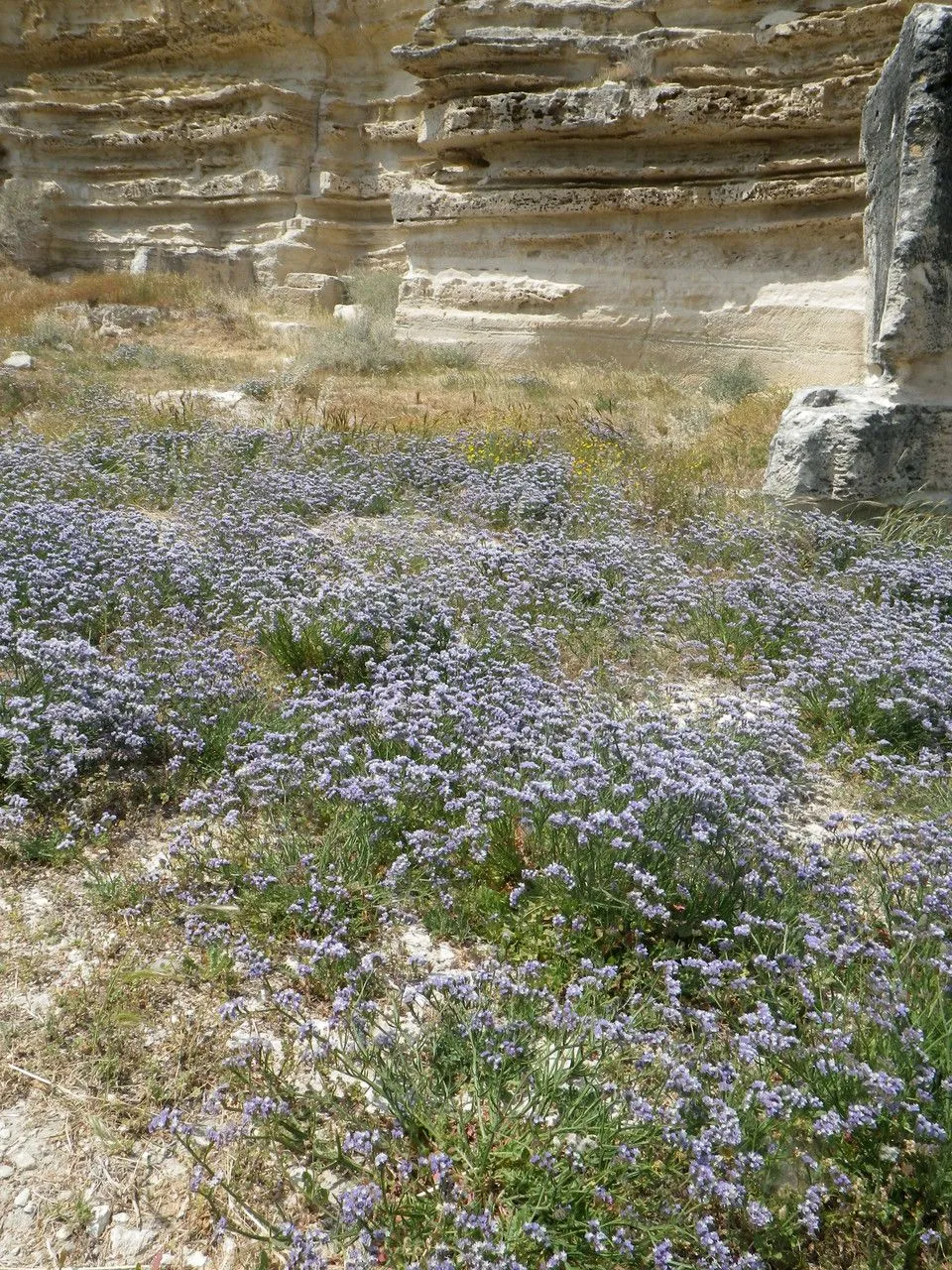
Author: (L.) Mill.
Bibliography: Gard. Dict. ed. 8: n.º 6 (1768)
Year: 1768
Status: accepted
Rank: species
Genus: Limonium
Vegetable: False
Observations: Macaronesia, Medit. to W. Sahara and W. Caucasus
Notchleaf sea-lavender, scientifically known as Limonium sinuatum, is an intriguing and visually striking member of the Plumbaginaceae family. This perennial plant thrives in the unique climates of Macaronesia, the Mediterranean, Western Sahara, and the Western Caucasus, showcasing its adaptability to diverse geographical regions.
Characterized by its vibrant and delicate blooms, the Notchleaf sea-lavender is a favorite among garden enthusiasts for its ornamental value. The plant features an array of colors ranging from violet and pink to white and yellow, making it a stunning addition to any landscape. Its flowers are arranged in an eye-catching, papery inflorescence that retains its beauty even when dried, making it a popular choice for dried flower arrangements and crafts.
The foliage of Limonium sinuatum is equally fascinating with its deeply lobed, notch-edged leaves that give the plant its common name. These leaves form a basal rosette, providing a lush, green base that complements the vivid hues of the flowers.
First described in the 18th century by the botanist Philip Miller, as recorded in the Gardener’s Dictionary’s eighth edition in 1768, the Notchleaf sea-lavender has a rich historical background in botanical literature. Originally identified by Carl Linnaeus, the plant’s taxonomy was later refined by Miller, as denoted by the author abbreviation (L.) Mill.
Notchleaf sea-lavender is not only prized for its beauty but also for its hardiness. It thrives in sandy, well-drained soils and is highly tolerant of saline conditions, making it an excellent choice for coastal gardens. This resilience, combined with its low maintenance requirements, makes it a robust option for gardeners seeking a splash of perennial color with minimal effort.
In summary, Limonium sinuatum is a testament to the diversity and adaptability of the Plumbaginaceae family. Its aesthetic appeal, resilience, and rich botanical history make the Notchleaf sea-lavender a cherished plant among horticulturists and garden artists alike.
Dan: bugtet hindebæger, vinget hindebæger
Deu: geflügelter strandflieder
Fra: limonium à feuilles sinuées, saladelle à feuilles sinuées, statice sinué
Eng: wavyleaf sea lavender, notchleaf sea-lavender, perennial sea-lavender, statice, wavyleaf sealavender
Swe: blårisp, blårisp/gulrisp
Por: estátice, lavanda-do-mar
En: Notchleaf sea-lavender, Perennial sea-lavender, Statice, Wavyleaf sea lavender, Wavyleaf sealavender, Garden Statice, Wavyleaf Sea-lavender, Winged Sea-lavender
Da: Bugtet hindebæger, Vinget hindebæger
Fr: Limonium à feuilles sinuées, Saladelle à feuilles sinuées, Statice sinué
De: Geflügelter Strandflieder
He: עדעד כחול
It: Limonio sinuato
Pt: Estátice, Lavanda-do-mar
Sv: Blårisp, Blårisp/gulrisp
© copyright of the Board of Trustees of the Royal Botanic Gardens, Kew.
© copyright of the Board of Trustees of the Royal Botanic Gardens, Kew.
© copyright of the Board of Trustees of the Royal Botanic Gardens, Kew.
Taken Sep 19, 2020 by L Mrx (cc-by-sa)
Taken Dec 21, 2021 by César Gonzalez (cc-by-sa)
Taken Sep 24, 2018 by Cornel Buzea (cc-by-sa)
Taken Aug 13, 2017 by Yan-hui Zhou (cc-by-sa)
Taken Nov 1, 2017 by Linda Lawliss (cc-by-sa)
Taken Feb 8, 2015 by Tela Botanica − Ans GORTER (cc-by-sa)
Taken Feb 6, 2016 by Tela Botanica − Ans GORTER (cc-by-sa)
Taken Feb 6, 2016 by Tela Botanica − Ans GORTER (cc-by-sa)
Taken May 3, 2022 by Renaud Brochiero (cc-by-sa)
Taken Jan 16, 2022 by Tristan Jaton-Maria (cc-by-sa)
Taken Jul 4, 2021 by R H (cc-by-sa)
Taken Jun 19, 2022 by Emma Franklin (cc-by-sa)
Taken Apr 20, 2018 by Tela Botanica − Liliane Roubaudi (cc-by-sa)
Taken Sep 20, 2021 by Fabrice Rubio (cc-by-sa)
Taken Aug 26, 2020 by Sylvain Piry (cc-by-sa)
Taken Feb 19, 2020 by Bailey Lou (cc-by-sa)
Taken Oct 13, 2021 by chris rahner (cc-by-sa)
Taken Jun 19, 2022 by Emma Franklin (cc-by-sa)
Taken Aug 26, 2020 by Sylvain Piry (cc-by-sa)
Taken Sep 20, 2021 by Fabrice Rubio (cc-by-sa)
Taken Aug 26, 2022 by Dieter Albrecht (cc-by-sa)
Taken May 30, 2020 by Karim BOUDANI (cc-by-sa)
Taken Feb 6, 2016 by Tela Botanica − Ans GORTER (cc-by-sa)
Taken Apr 20, 2018 by Tela Botanica − Liliane Roubaudi (cc-by-sa)
Taken Feb 8, 2015 by Tela Botanica − Ans GORTER (cc-by-sa)
Taken Jan 4, 2021 by Filip Pietrak (cc-by-sa)
Taken Jan 22, 2022 by Talilalitalala (cc-by-sa)
Taken Sep 25, 2021 by defebvre jose (cc-by-sa)
Growth habit>: Forb/herb
Ph maximum: 8.0
Ph minimum: 7.5
Light: 9
Atmospheric humidity: 5
Bloom months: [‘may’, ‘jun’, ‘jul’, ‘aug’, ‘sep’]
Soil nutriments: 3
Family: Myrtaceae Author: (F.Muell.) K.D.Hill & L.A.S.Johnson Bibliography: Telopea 6: 402 (1995) Year: 1995 Status:…
Family: Rubiaceae Author: Pierre ex A.Froehner Bibliography: Notizbl. Bot. Gart. Berlin-Dahlem 1: 237 (1897) Year:…
Family: Sapindaceae Author: Koidz. Bibliography: J. Coll. Sci. Imp. Univ. Tokyo 32(1): 38 (1911) Year:…
Family: Asteraceae Author: A.Gray Bibliography: Pacif. Railr. Rep.: 107 (1857) Year: 1857 Status: accepted Rank:…
Family: Fabaceae Author: Medik. Bibliography: Vorles. Churpfälz. Phys.-Ökon. Ges. 2: 398 (1787) Year: 1787 Status:…
Family: Aspleniaceae Author: (Cav.) Alston Bibliography: Bull. Misc. Inform. Kew 1932: 309 (1932) Year: 1932…